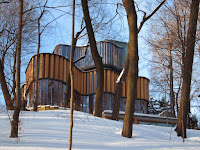A Mathematically-Inclined Cucumber in the Sky
Standing 591-feet tall, with 41 floors is London’s skyscraper known as The Gherkin (yes, like the cucumber). The modern tower was carefully constructed with the help of parametric modeling amongst other math-savvy formulas so the architects could predict how to minimize whirlwinds around its base. The design’s tapered top and bulging center maximize ventilation. The building uses half the energy of other towers the same size. Any mathematician would be pleased to claim credit for the building, but architectural firm Foster and Partners might have something to say about that.
Experimental Math-Music Pavilion
Imagine walking up to the Philips Pavilion at the 1958 World’s Fair and seeing this crazy construction of asymmetric hyperbolic paraboloids and steel tension cables. Mind. Blown. This amazing building appeared at the first Expo after World War II, so it was an important moment that allowed its creators to show off the technological progress the world had made since the devastating battle. Philips Electronics Company wanted to create a unique experience for visitors, so they collaborated with an international group of renown architects, artists, and composers to create the experimental space. ArchDaily wrote about the groundbreaking, temporary building, calling it the “first electronic-spatial environment to combine architecture, film, light and music to a total experience made to functions in time and space. It was through these visually inspired concepts that elevated the Philips Pavilion into a complete experience where one could visualize their special movements through a space of sound, light, and time.” Poeme Electronique was one of the works prominently displayed at the time.
A classical violinist commissioned an eccentric, $24 million dollar home located on the edge of a Toronto ravine. The curved, elegant structure — which also serves as an incredible concert space for 200 people — was named the Integral House. (Calculus geeks, represent!) The home’s owner Jim Stewart was a calculus professor who wrote textbooks and wanted to incorporate the mathematical sign into the home’s name and design. Undulating glass and wood walls also echo the shape of a violin.
Reference:
flavorwire.com/330293/10-amazing-examples-of-architecture-inspired-by-mathematics
Reference:
flavorwire.com/330293/10-amazing-examples-of-architecture-inspired-by-mathematics



No comments:
Post a Comment